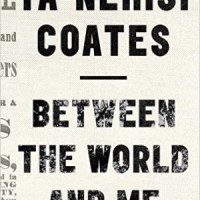In a 2001 appreciation of Chester Himes in the New Yorker, Hilton Als tells the story of a 1953 encounter between Himes, Richard Wright, and James Baldwin at Les Deux Magots in Paris. Then 29, and a recent expatriate, Baldwin had made his reputation in part with his critical writing, which had been unkind to both older writers, and particularly to Wright. Nevertheless, Baldwin wanted to ask Himes and Wright for money. In his autobiography (which is Als’ source for the anecdote), Himes recalls the meeting dissolving into an acrimonious discussion of literature between Baldwin and Wright, and Himes claims to have stopped listening. Als concludes:
So, on that Paris evening, [Himes] failed to recognize that his compatriots weren’t discussing the finer points of literature—that, unlike the former college boy sharing their table, Wright and Baldwin were gladiators by necessity, fighting, at Les Deux and in parlors around the Faubourg Saint-Germain, to establish whose spear was long enough to piece their largely white audience’s consciousness, and appoint its wielder head literary Negro.
In Als’s retelling, the scene recalls the “Battle Royale” chapter in Ralph Ellison’s Invisible Man. It also seems to belong to another era. Sixty-two years after Wright and Baldwin squared off at Les Deux, vast cultural changes have allowed for a multiplicity of African American writers, and other writers of color, to connect with audiences. Nevertheless, the same questions plague the receptions afforded those writers. As in Percival Everett’s brilliant, despairing 2001 novel Erasure, one author’s experience comes to stand for that of an entire arbitrary (and false) racial category. By venerating one black writer above all others, white liberal audiences erase a myriad of alternative voices. Moreover, they do a disservice to the writer they presume to elevate.
Since the Black Lives Matter movement took hold, Ta-Nehisi Coates has hit his stride; indeed, his work seems so much of the moment, Spiegel and Grau pushed up the release for his memoir, Between the World and Me, from September to July. Composed in the form of a letter to his son—a choice that recalls The Fire Next Time—Coates’s new book invites comparisons to Baldwin. Weaving together personal experience and political writing, Coates argues that racial inequality in the United States lands with brutal, often deadly force on the black body. Between the World and Me is a chronicle of a historical moment and a text that deserves the place it will hopefully find in the canon of writing about fatherhood, filial love, and race in the United States.
The book begins with an anecdote about appearing on a “popular news show” in the wake of national protests over the acquittals of the police officers that killed Michael Brown and Eric Garner. After a discussion of the political context for the demonstrations, the host presented Coates with an image that had been making the rounds on social media:
But at the end of the segment, the host flashed a widely shared picture of an eleven-year-old black boy tearfully hugging a white police officer. Then she asked me about “hope.” And I knew then that I had failed. And I remembered that I had expected to fail. And I wondered again at the indistinct sadness welling up in me.
Time and again, in Between the World and Me, Coates writes about failure: the failure of efforts to change the structural inequalities that perpetuate institutionalized racism. He writes about the futility of confronting the psychology that refuses to recognize that inequalities exist. That same specter of failure haunts Coates’s recollection of watching his son absorb the Michael Brown verdict:
You stayed up till 11 P.M. that night, waiting for the announcement of an indictment, and when instead it was announced that there was none you said, “I’ve got to go,” and you went into your room, and I heard you crying. I came in five minutes after, and I didn’t hug you, and I didn’t comfort you, because I thought it would be wrong to comfort you. I did not tell you it would be okay, because I have never believed it would be okay.
While in other contexts, it might be easy to mistake Coates’s pessimism for a copout (see his otherwise excellent conversation with New Orleans mayor Mitch Landrieu on You Tube), in Between the World and Me, his refusal to find comfort constitutes one of the most compelling aspects of the book.
In some respects, Between the World and Me reads like a primer on radical politics. While to readers steeped in race theory, the insight that “white” constitutes an imaginary category might seem familiar, to other readers, it might come as a revelation. Coates’s dissection of the fiction of racial categories is sharp, insightful, and funny:
You see this from time to time when some dullard—usually believing himself white—proposes that the only way forward is a grand orgy of black and white, ending only when we are all beige and thus the same “race.” But a great number of “black” people are already beige. And the history of civilization is littered with dead “races” (Frankish, Italian, German, Irish) later abandoned because they no longer serve their purpose—the organization of people beneath, and beyond, the umbrella of rights.
Coates depicts this dream (“the Dream” Coates calls it) as the fiction of whiteness, predicated upon the fiction of blackness. Because whiteness confers belonging, it necessitates the exclusion of people who belong to the latter racial category. The institutions charged with empowering individuals perpetuate this exclusion: “No one directly proclaimed that schools were designed to sanctify failure and destruction. But a great number of educators spoke of ‘personal responsibility’ in a country authored and sustained by a criminal irresponsibility.” Of the destruction of the black body in the United States, Coates writes, “it is heritage.”
These ideas hit home in the story of Prince Jones, an acquaintance from Howard University whose grandmother had been a sharecropper, whose mother had been a radiologist, and who was murdered by a police officer, who had tailed him across state lines in what turned out to be a case of mistaken identity. “Prince Jones was the superlative of all my fears. And if he, good Christian, scion of a striving class, patron saint of the twice as good, could be forever bound, who then could not?” Gunned down in his fiancée’s driveway by a black cop empowered to kill by black politicians—for Coates Jones represents the betrayal of the promises of the Civil Rights Movement, as well as an indictment of the effectiveness of nonviolent resistance. His story implicates the belonging “the Dream” depends upon, and resonates with passages drawn from Coates’s personal experience: his childhood recollection of seeing a teenager draw a gun in Baltimore; of his father’s mantra, “Either I can beat him or the police”; of a white man threatening to have Coates arrested because he’d confronted a white woman who had shoved his child; and even of his ambiguous feelings on the morning of September 11, 2001: “I kept thinking about how Southern Manhattan had always been Ground Zero for us. They auctioned our bodies down there, in that same devastated, and rightly named, financial district.” The fiction of race proves most damning for what it justifies: the exclusion upon which belonging depends.
The connection between the political and the personal—between the practice of redlining and the physical and psychological toll of living in racially segregated neighborhoods—constitutes Ta-Nehisi Coates’s contribution to contemporary political writing. Half a century after Civil Rights, seven years after the election of the first African American president, glaring inequalities persist, making that articulation especially important. Apparently, Coates stumbled upon the epistolary form after several drafts and that proved a turning point in the evolution of the manuscript: a father’s love for his son makes this story connect, and Coates’s visceral fear for his son’s safety lends additional weight to his political insights. Fans of his blog at The Atlantic will recognize ideas he has worked out there, and it’s gratifying to see those developed and woven into the manuscript. Between the World and Me also represents an evolution in Coates’s prose style. As potent as some of the passages were in his previous book The Beautiful Struggle, his language slipped too easily into abstraction, lacking the concrete qualities that ground his prose in Between the World and Me.
Occasionally, the book flounders on its author’s rhetoric. While Coates’s prize-winning essay, “The Case for Reparations,” laid out the hard facts behind his claims about housing discrimination in Chicago in the twentieth century, Between the World and Me glosses those same facts. Fair enough, he’s already made his case. But he made it elsewhere. And without that scholarship, Coates’s prose—which sustains its elevated level for 152 pages—seems a little thin. Nevertheless, though commentators like David Brooks have pilloried Coates for being the darling of white liberals, Coates didn’t write Between the World and Me with white liberals foremost in mind. The book is rooted in the physical facts of the black American experience, and its rhetorical style is not fundamentally argumentative. “You cannot forget how much they took from us and how they transfigured our very bodies into sugar, tobacco, cotton, and gold,” Coates tells his son, the word transfigured suggesting the redemption the end of the book hints at, despite Coates’s pessimism.
In the end, that hint of redemption constitutes the real connection between Coates—a professed atheist—and James Baldwin, and it probably accounts for Cornel West’s Facebook diatribe about Coates, and for Coates’s “majoritarian” appeal. Unlike most radicals, liberal Americans like to think the nation will improve. As his choice of Ulysses S. Grant for his Twitter avatar suggests, perhaps in spite of himself, Ta-Nehisi Coates would seem to agree.
The form of Between the World and Me makes comparisons between Coates and Baldwin inevitable, as does a laudatory blurb by Toni Morrison that references Baldwin. Yet, while Coates and Baldwin share an exhortative prose style and a concern with the redemptive possibilities of black suffering, Coates belongs to an age in which social media has democratized discourse.
Yet, with the reception afforded Between the World and Me, critics on both sides resort to hyperbole: either Coates is “like water or air,” in one well-meaning but embarrassingly earnest formulation (which is to say, he is the black writer), or he doesn’t live up to a standard he shouldn’t be judged by in the first place (which is to say, he’s not worthy of being the black writer). As in Baldwin’s, Wright’s, and Himes’s time, so it remains in our own. That’s not a knock against Coates. Instead, it reflects how race—and racism—affects the way people read. By no means is Between the World and Me a perfect book. Yet Ta-Nehisi Coates shares James Baldwin’s capacity to look into the maw of history and recognize the human, and that makes Between the World and Me worthy of Baldwin’s legacy. Hopefully, that will cause Coates’s most ardent fans to seek out writers like Brittney Cooper, Jelani Cobb, Mia McKenzie, or Roxane Gay—or John Edgar Wideman, Nella Larson, and the many others who are part of the same rich tradition to which Coates and Baldwin belong.






One response
Excellent review.
Click here to subscribe today and leave your comment.